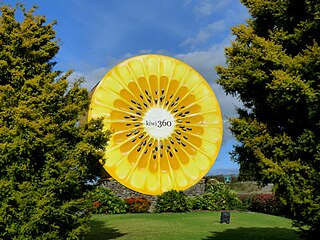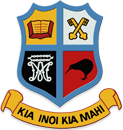The education system in New Zealand is a three-tier model which includes primary and intermediate schools, followed by secondary schools and tertiary education at universities and polytechnics. The academic year in New Zealand varies between institutions, but generally runs from early February until mid-December for primary schools, late January to late November or early December for secondary schools and polytechnics, and from late February until mid-November for universities.

Te Puke is a town located 28 kilometres southeast of Tauranga in the Western Bay of Plenty of New Zealand. It is particularly famous for the cultivation of kiwifruit.
Ruatoria is a town in the Waiapu Valley of the Gisborne Region in the northeastern corner of New Zealand's North Island. The town was originally known as Cross Roads then Manutahi and was later named Ruatorea in 1913, after the Māori Master female grower Tōrea who had some of the finest storage pits in her Iwi at the time. In 1925 the name was altered to "Ruatoria", although some texts retain the original spelling.

Ōtaki is a town in the Kapiti Coast District of the North Island of New Zealand, situated half way between the capital city Wellington, 70 km (43 mi) to the southwest, and Palmerston North, 70 km (43 mi) to the northeast.
Rutherford College is a co-educational state secondary school on the Te Atatū Peninsula, Auckland, New Zealand. It is named after New Zealand-born nuclear physicist and chemist Ernest Rutherford.

Avondale College is a state coeducational secondary school located in the central Auckland, New Zealand, suburb of Avondale. With a roll of 2693 students from Years 9–13, it is the third largest secondary school in New Zealand.

Henderson High School is a co-educational secondary school in the West Auckland suburb of Henderson, New Zealand, catering for students from Year 9 to Year 13. Many notable alumni attended Jubilees held in 2003 (50th) and 2013 (60th). Historically the school has always been an important part of the community and stability of leadership has ensured that it is well resourced with a wide range of facilities. Recent reviews by the Education Review Office have been positive.
Tamatea High School is a state secondary co-educational school located in Napier, New Zealand. The school was opened in 1975.
Southern Cross Campus is a composite school that caters for students in Years 1-13 in the suburb of Mangere East in Auckland, New Zealand. The school has deep ties to the Mangere East community by providing education, facilities, and programmes for the wider use of the whole school. It is a Māori and Pacific Islands ethnic school, with students of European (Pākehā), Asian, and other ethnicities as a 0.5% minority.

Papakura High School (PHS) is a co-educational state secondary school based in the Auckland suburb of Papakura in New Zealand, catering for students from Year 9 to Year 13.
Ngāti Raukawa is a Māori iwi with traditional bases in the Waikato, Taupo and Manawatu/Horowhenua regions of New Zealand. In 2006, 29,418 Māori registered their affiliation with Ngāti Raukawa.
Western Springs College is a state co-educational secondary school located in Western Springs, an inner suburb of Auckland, New Zealand. The school educates approximately 1739 students, from Years 9 to 13. The school was originally part of Seddon Memorial Technical College, but was moved to the current Western Springs site in 1964.
Fairfield College is a co-educational state secondary school in Hamilton, New Zealand. Located in the north-east suburb of Fairfield, it was founded in 1957. Built on the site of a former 36-acre (150,000 m2) dairy farm which is leased from Tainui iwi, it is one of the largest school sites in the country.

Clifford Hamilton Whiting was a New Zealand Māori artist, heritage advocate and teacher. Whiting was born and raised in Te Kaha, New Zealand, and affiliated to the Te Whānau-ā-Apanui tribe.

Hato Petera College was an integrated, co-educational college in Northcote Central, Auckland, New Zealand for students from Year 9 to Year 13. It existed for 90 years, opening on 3 June 1928 and closing on 31 August 2018. The school had a strong Catholic and Māori character. It was located on part of the land originally given by Sir George Grey, Governor of New Zealand, to Bishop Pompallier, the first Bishop of Auckland, in 1849 for education purposes.

Sir "Sidney" Hirini Moko Haerewa Mead is a New Zealand anthropologist, historian, artist, teacher, writer and prominent Māori leader. Initially training as a teacher and artist, Mead taught in many schools in the East Coast and Bay of Plenty regions, and later served as principal of several schools. After earning his PhD in 1968, he taught anthropology in several universities abroad. He returned to New Zealand in 1977 and established the first Māori studies department in the country. Mead later became a prominent Māori advocate and leader, acting in negotiations on behalf of several tribes and sitting on numerous advisory boards. He has also written extensively on Māori culture. He is currently the chair of the council of Te Whare Wānanga o Awanuiārangi.
Te Kura Kaupapa Māori o Te Koutu is a co-educational Māori immersion school in Rotorua, New Zealand offering education within a unique Maori environment for Māori students from Year 1 to Year 13. Te Koutu students from year 1 - 13 learn Spanish as well as Māori and English.
Hukarere Girls' College is a girls secondary boarding school in the Hawke's Bay Region of New Zealand. It has a strong Māori character and follows the Anglican tradition. The School motto "Kia Ū Ki Te Pai" means "Cleave to that which is good" or "Abhor that which is evil".

Kelston Girls’ College (KGC) is a single-sex girls state secondary school in Kelston, a suburb in the Waitakere region of Auckland, New Zealand. It was created in 1963 when the roll of Kelston High School became too large for the site on the corner of Archibald and Great North Roads. The boys moved to a new site further down Archibald Road and the original site became the home of Kelston Girls' High School.

Carla Marja Olga Van Zon is a New Zealand retired artistic director. She worked on international opportunities for New Zealand artists at Creative New Zealand, before becoming artistic director of the New Zealand International Festival of the Arts in Wellington in 1996. From 2013 she was the Artistic Director of the Auckland Arts Festival, where she was responsible for commissioning works such as the opera The Bone Feeders. Van Zon has been responsible for supporting the careers of many New Zealand artists. She retired from the Auckland Arts Festival in 2017, following a diagnosis of kidney disease in 2016.











